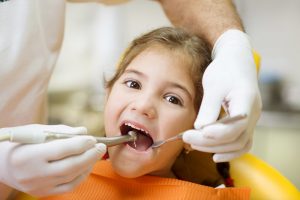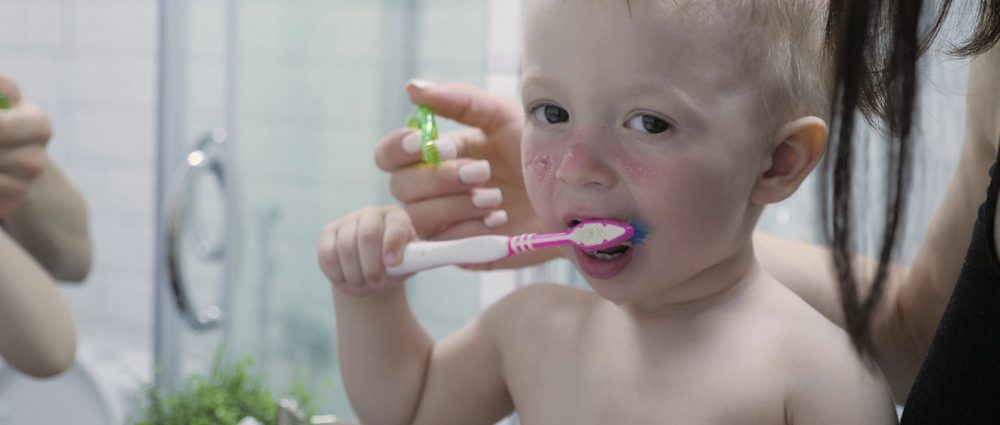
Highlights
- Start brushing as soon as the first tooth appears using a soft-bristled, child-sized toothbrush.
- Brush twice a day for two minutes — once in the morning and once before bed.
- Teach gentle, circular brushing motions on the front, back, and chewing surfaces of all teeth.
- Supervise and assist brushing until around age 7 or 8, when children can reliably brush on their own.
- Turn brushing into a fun, daily routine with songs, games, sticker charts, or a two-minute timer.
- Limit sugary foods and drinks to reduce the risk of tooth decay.
- Schedule your child’s first dental visit by their first birthday or within six months of the first tooth erupting.

Teaching your child how to brush their teeth properly is one of the most important habits you can help them develop. Besides choosing to recommend a local dentist in Meridian, ID that accepts insurance in their young adulthood, good oral hygiene in early childhood helps prevent cavities, gum problems, and tooth decay, which can affect a child’s overall health and confidence. More importantly, early oral care habits often carry into adulthood, promoting a lifetime of healthier smiles.
Many parents wonder when to start brushing, how much toothpaste is safe for a child, and how to encourage consistent brushing routines. If you’ve asked yourself these same questions, you’re not alone. Keep reading to learn about when and how to help your child brush effectively, common mistakes to avoid, and how to make toothbrushing a fun, daily ritual.
When Should I Start Brushing My Child’s Teeth?
The American Dental Association (ADA) recommends that parents begin brushing their child’s teeth as soon as the first tooth appears, which usually happens between six months and one year of age. Before teeth erupt, you can wipe your baby’s gums gently with a clean, damp cloth after feedings to reduce bacteria and get them comfortable with oral care.
Once the first tooth comes in, start using a child-sized, soft-bristled toothbrush with a tiny smear of fluoride toothpaste, about the size of a grain of rice. As more teeth appear, continue brushing twice a day. At around age three, you can increase the amount of toothpaste to a pea-sized amount. Early brushing habits play a crucial role in preventing cavities and familiarizing your child with the idea that dental care is a daily responsibility.
How to Brush a Child’s Teeth Correctly
Proper technique is essential, especially when young children may not have the coordination to brush thoroughly. Start by placing the toothbrush at a 45-degree angle to your child’s gums. Use gentle, circular motions on the front, back, and chewing surfaces of every tooth. Be sure to brush for a full two minutes — about 30 seconds per quadrant of the mouth.
Use a soft-bristled, small-headed toothbrush designed for children. Always brush your child’s teeth twice daily: once in the morning and again before bedtime. Brushing at night is especially important since sugars from food and milk can sit on the teeth overnight and contribute to tooth decay. Until your child is around seven or eight years old, you should assist or supervise their brushing to make sure no areas are missed. Once they’re older, you can recommend a local dentist in Meridian, ID that accepts insurance.

Common Brushing Mistakes to Avoid
Even with good intentions, it’s easy to overlook a few important details when teaching your child to brush. One frequent mistake is letting children brush on their own too soon. Young kids typically lack the dexterity to clean every tooth properly and may miss hard-to-reach areas like back molars or the gumline.
Another common issue is using too much toothpaste. Young children often swallow toothpaste, so it’s important to stick to a rice-sized smear for children under three and a pea-sized amount for those aged three to six. Also, make sure to replace your child’s toothbrush every three to four months, or sooner if the bristles become frayed. Lastly, avoid letting your child fall asleep with a bottle or sippy cup containing milk or juice, as this can lead to baby bottle tooth decay.
How to Make Brushing Fun for Kids
For many families, the biggest challenge isn’t knowing how to brush — it’s getting children excited about doing it. Thankfully, with a little creativity, you can turn toothbrushing into an enjoyable part of your child’s daily routine. Start by letting your child choose their own toothbrush featuring a favorite character or color. Similarly, offer them a selection of fun, child-friendly toothpaste flavors like strawberry, bubblegum, or mild mint.
You can also play a two-minute song, set a timer, or use a brushing app to help your child brush for the recommended amount of time. Sticker charts, small rewards, and brushing together as a family can also motivate young children. Making brushing a shared activity allows you to demonstrate proper techniques while reinforcing the message that dental care is important for everyone, not just kids.
Encourage Other Healthy Oral Habits
Toothbrushing is just one part of maintaining your child’s oral health. Teaching other healthy habits is equally important for cavity prevention. Limit sugary snacks and drinks, especially sticky candies and juice, which can linger on the teeth and feed decay-causing bacteria. Encourage your child to drink water after snacks and meals to help rinse away food particles.
Once two teeth touch, you should begin flossing between them daily to remove plaque and debris from areas a toothbrush can’t reach. Dental flossers made for children can make this process easier and more appealing. Also, schedule your child’s first dental appointment by their first birthday or within six months of their first tooth appearing. Regular checkups allow the dentist to monitor development, provide cleanings, and catch any potential issues early.
What to Expect at a Child’s First Dental Visit
A child’s first dental visit is typically short and gentle, designed to introduce them to the dental environment in a positive way. During the appointment, the dentist will check for signs of tooth decay, assess bite alignment, and evaluate oral tissue health. They’ll also offer personalized guidance on brushing and fluoride use based on your child’s age and risk factors.
The American Academy of Pediatric Dentistry (AAPD) recommends establishing a “dental home” for your child early, meaning a consistent dental office where they receive ongoing care. Early and regular dental visits help children become comfortable with dental care and reduce the likelihood of dental anxiety as they get older.
Lead by Example
Children learn by watching the adults around them, and oral care is no exception. One of the most effective ways to teach your child about the importance of brushing is to model good habits yourself. Let your child watch you brush and floss daily and explain why it’s important for keeping your teeth clean and healthy.
If possible, make brushing a family activity, especially in the evenings. Not only does this reinforce consistency, but it also turns brushing time into a shared experience. When kids see their parents taking care of their own teeth, it sends a clear message that oral health matters at every age.
Helping your child brush their teeth properly requires patience, consistency, and a bit of creativity. By starting early, using the right techniques, and making toothbrushing fun, you can set the foundation for a lifetime of good oral hygiene. Remember to supervise brushing until your child is old enough to handle it independently and schedule regular dental visits to keep their teeth healthy and strong. Even once they’re out of your home, you can still recommend a local dentist in Meridian, ID that accepts insurance.
Toothbrushing isn’t just about preventing cavities in baby teeth — it’s about building daily habits that contribute to overall well-being. By offering guidance, encouragement, and leading by example, you’ll empower your child with the tools they need for a bright, confident smile.

